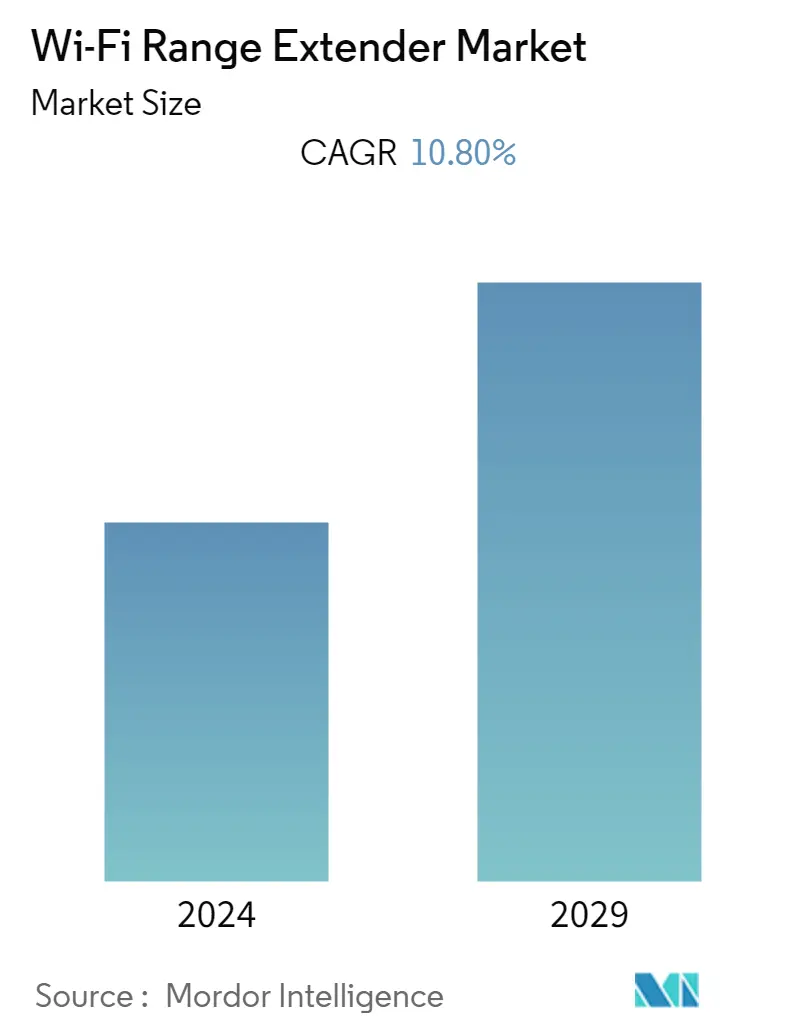Market Size of Wi-Fi Range Extender Industry

| Study Period | 2019 - 2029 |
| Base Year For Estimation | 2023 |
| CAGR | 10.80 % |
| Fastest Growing Market | Asia Pacific |
| Largest Market | North America |
| Market Concentration | Low |
Major Players
*Disclaimer: Major Players sorted in no particular order |
Wi-fi Range Extender Market Analysis
The Wi-Fi range extender market is expected to register a CAGR of 10.8 % during the forecast period. The market is expected to witness robust growth over the forecast period due to the growing demand for internet access and the increasing number of consumer electronics devices globally, primarily in the residential sector.
- The ease of installation and cost benefits associated with the purchase of an extender compared to adding another Wi-Fi router, essentially performing the same function of extending the Wi-Fi coverage, is a significant advantage that plays a vital role in increasing the sales of the Wi-Fi range extenders, mainly in the commercial and residential sectors.
- The rapid growth of connected homes and the emergence of the smart home ecosystem are other factors expected to boost the market's growth. Additionally, the demand for wireless routers is rising from the growing consumer preference toward installing smart devices in the homes, such as smart TVs, smartphones, and tablets, among many other appliances.
- The emergence of the BYOD trend in the corporate sector has further propelled the use of wireless routers in the commercial space. The rapid growth and development of the consumer electronics, safety, and security industries have developed a pattern that is creating new economic opportunities. As a result, the global market for Wi-Fi range extenders is expanding. Growing knowledge of different technological breakthroughs significantly boosts market demand for Wi-Fi range extenders. Customization, industry-specific testing services, fast-changing trends, and customer preferences drive the market demand for Wi-Fi range extenders.
- Moreover, the growing cybersecurity concerns with the inclusion of smart devices are analyzed to hamper the market growth during the forecast period. Wi-Fi can be attacked by default or weak SSIDs or passwords and insecure encryption techniques. The attacker can easily access the router using the default credentials. Strong Wi-Fi passwords make hackers search for more challenging entry points to the network. The most typical methods used by hackers to access networks are sniffing and encryption breaking. Therefore, the growing cybersecurity concerns are analyzed to restrain the market studied during the forecast period.
- Employees have also been witnessed accessing the company network using personal Wi-Fi internet connections. This unexpected interruption caused by the COVID-19 epidemic increased the adoption of the Wi-Fi range extender to keep companies and key operations running. Furthermore, various sectors throughout the globe recovered from the COVID-19 epidemic by participating in bandwidth-hungry applications, including voice, video, and IoT devices. As a result, as demand for Wi-Fi grows, wireless networks become oversubscribed, forcing associated IT teams to limit application performance. With the increased use of connected devices for smart homes and smart cities, the market is growing rapidly post-pandemic.
Wi-fi Range Extender Industry Segmentation
A Wi-Fi range expander or a Wi-Fi Booster is a communication device that repeats the wireless signal from the base router to expand the Wi-Fi coverage. It basically functions as a bridge, capturing the WiFi from the base router and rebroadcasting it to areas where the Wi-Fi signal is weak or nonexistent, improving the performance and range of the Wifi router.
The Wi-Fi Range Extender Market is segmented by Type (Indoor Wi-Fi, Outdoor Wi-Fi), by Product (Extenders and Repeaters, Access Points, Antennas), by End User (Residential, Commercial, Public), by Geography (North America, Europe, Asia Pacific, Latin America, Middle East and Africa).
The market sizes and forecasts are provided in terms of value in USD million for all the above segments.
| By Type | |
| Indoor Wi-Fi | |
| Outdoor Wi-Fi |
| By Product | |
| Extenders and Repeaters | |
| Access Points | |
| Antennas |
| By End User | |
| Residential | |
| Commercial | |
| Public | |
| Other End-user Verticals |
| By Geography | |
| North America | |
| Europe | |
| Asia Pacific | |
| Latin America | |
| Middle East and Africa |
Wi-Fi Range Extender Market Size Summary
The Wi-Fi range extender market is poised for significant growth, driven by the increasing demand for internet access and the proliferation of consumer electronics, particularly in residential settings. The market benefits from the cost-effectiveness and ease of installation of extenders compared to additional routers, making them a preferred choice for both commercial and residential users. The rise of connected homes and smart home ecosystems further propels market expansion, as more consumers install smart devices that require robust wireless connectivity. The corporate sector's adoption of the BYOD trend has also contributed to the increased use of wireless routers, creating new economic opportunities within the consumer electronics, safety, and security industries. However, cybersecurity concerns related to smart devices pose potential challenges to market growth, as vulnerabilities in Wi-Fi networks can be exploited by attackers.
The market's growth is further supported by the rapid development of smart cities, which demand extensive wireless infrastructure to support smart systems and IoT devices. The North American region leads the market, with a strong presence of vendors and a high adoption rate of IoT devices in smart homes. The fragmented nature of the market sees major players like D-Link Corporation, Linksys Group Inc., and Cisco Systems Inc. engaging in strategic partnerships and acquisitions to enhance their offerings. Recent product launches, such as Shenzhen Tenda Technology Co., Ltd.'s MX6-3 AX1800 mesh Wi-Fi 6 system, highlight the industry's focus on expanding coverage and improving connectivity. As the demand for connected devices continues to rise, the Wi-Fi range extender market is expected to experience robust growth, driven by technological innovations and changing consumer preferences.
Wi-Fi Range Extender Market Size - Table of Contents
-
1. MARKET INSIGHTS
-
1.1 Market Overview
-
1.2 Industry Attractiveness - Porter's Five Forces Analysis
-
1.2.1 Threat of New Entrants
-
1.2.2 Bargaining Power of Buyers/Consumers
-
1.2.3 Bargaining Power of Suppliers
-
1.2.4 Threat of Substitutes
-
1.2.5 Intensity of Competitive Rivalry
-
-
1.3 Value Chain Analysis
-
1.4 Technology Snapshot
-
1.5 Assessment of Impact of COVID-19 on the Industry
-
-
2. MARKET SEGMENTATION
-
2.1 By Type
-
2.1.1 Indoor Wi-Fi
-
2.1.2 Outdoor Wi-Fi
-
-
2.2 By Product
-
2.2.1 Extenders and Repeaters
-
2.2.2 Access Points
-
2.2.3 Antennas
-
-
2.3 By End User
-
2.3.1 Residential
-
2.3.2 Commercial
-
2.3.3 Public
-
2.3.4 Other End-user Verticals
-
-
2.4 By Geography
-
2.4.1 North America
-
2.4.2 Europe
-
2.4.3 Asia Pacific
-
2.4.4 Latin America
-
2.4.5 Middle East and Africa
-
-
Wi-Fi Range Extender Market Size FAQs
What is the current Wi-Fi Range Extender Market size?
The Wi-Fi Range Extender Market is projected to register a CAGR of 10.80% during the forecast period (2024-2029)
Who are the key players in Wi-Fi Range Extender Market?
D-Link Corporation , Linksys Group Inc. , TRENDnet, Inc. , Shenzhen Tenda Technology Co.,Ltd. and Cisco Systems Inc. are the major companies operating in the Wi-Fi Range Extender Market.

